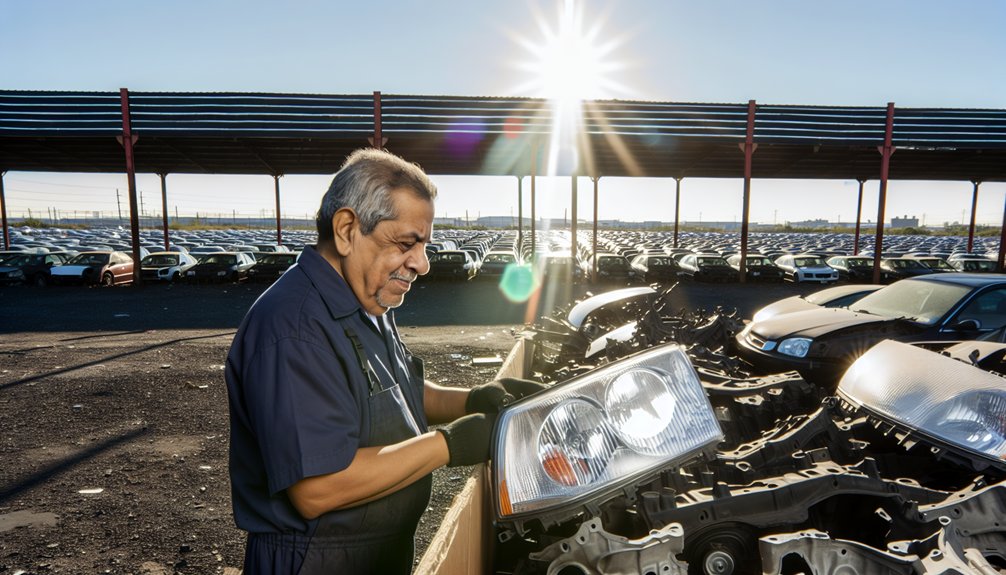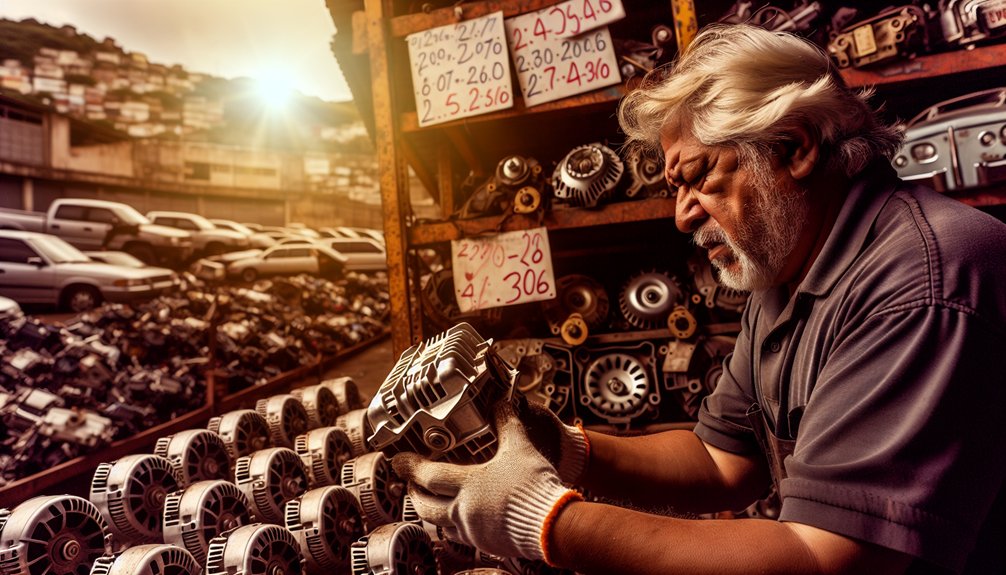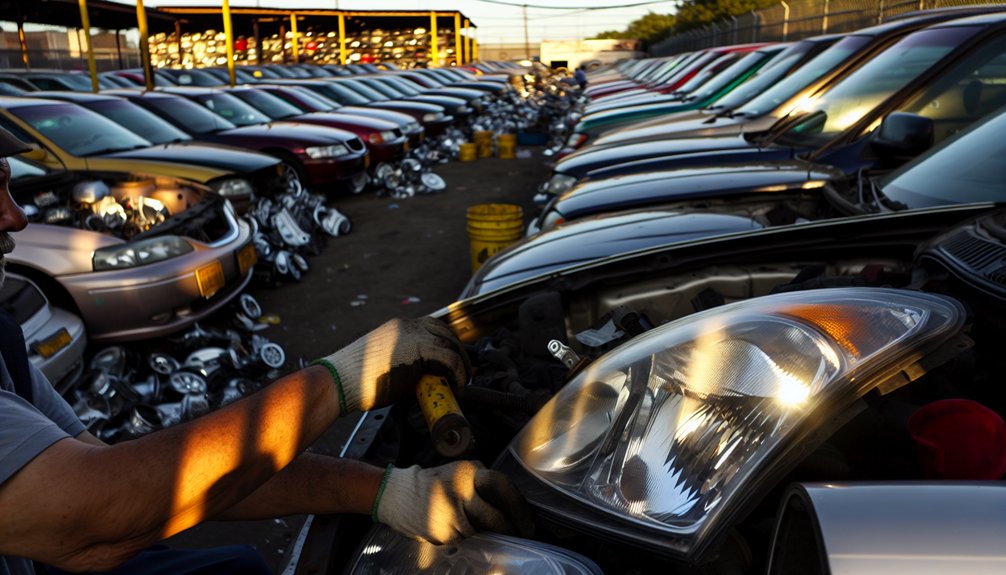Car owners seeking affordable replacement parts face a challenging market in Queens. Local junkyards offer practical alternatives to expensive dealership components, with potential savings of 50-70% on quality used parts. The borough houses several established salvage yards specializing in domestic and imported vehicles. Understanding which locations provide the best inventory, pricing structures, and customer service proves essential for cost-effective vehicle maintenance. The following examination identifies five premier Queens locations where budget-conscious mechanics and DIY enthusiasts can source reliable automotive components.
Key Takeaways
- A & T Auto Salvage offers competitive pricing and extensive inventory of affordable car parts in Queens.
- USJunkCars.com provides guaranteed price quotes and same-day service for customers seeking used parts.
- Visit junkyards early in the week (Mondays/Tuesdays) to access fresh inventory at better prices.
- Research typical part prices online before visiting multiple yards to gain negotiating leverage.
- JunkCarsUs maintains thorough inventories of essential components like engines, transmissions and body parts at lower costs.
Top Salvage Yards in Queens for Budget-Friendly Auto Parts

Several established salvage yards in Queens offer exceptional value for cost-conscious vehicle owners seeking quality used parts. A & T Auto Salvage, Inc. stands out for its competitive pricing on used auto parts and extensive inventory spanning numerous vehicle makes and models.
USJunkCars.com provides an efficient alternative with guaranteed price quotes and same-day service, streamlining the procurement of affordable parts. JunkCarsUs and similar Queens junkyards maintain thorough inventories of quality used parts at prices substantially below retail alternatives.
A significant advantage of these salvage yards is their skilled staff who help customers identify appropriate components for specific vehicle requirements.
Expert guidance from knowledgeable staff ensures customers find precisely the right parts for their vehicles.
The substantial savings available at these locations is remarkable—essential components such as bumpers, batteries, and transmissions can be purchased at a fraction of new part costs. These budget-friendly options enable vehicle owners to maintain their automobiles economically without compromising on component reliability.
How to Navigate Queens Junkyards for the Best Deals
Maneuvering through Queens junkyards effectively requires strategic planning and preparation to secure ideal pricing on quality used auto parts. Industry experts recommend researching establishments with stellar customer service records and affordable prices before visiting.
Consumers benefit from utilizing online forums to compare prices and parts availability across multiple locations.
Weekday visits yield optimal results, as decreased foot traffic enables staff to provide more personalized attention during the parts search process. Savvy patrons arrive equipped with necessary tools, prepared to remove parts independently—a practice that greatly reduces overall costs at most facilities.
Additionally, monitoring junkyards for ongoing promotions and seasonal discounts represents a vital strategy for maximizing savings. Many Queens salvage yards offer periodic specials that considerably reduce prices on specific components.
This systematic approach to junkyard navigation guarantees customers obtain necessary automotive parts while maintaining budgetary constraints.
Most Commonly Available Parts at Queens Auto Recyclers
Inventory abundance characterizes Queens auto recycling facilities, where customers can consistently locate high-demand automotive components at substantial discounts compared to retail alternatives.
Queens junk yards maintain extensive stocks of engines, transmissions, and catalytic converters—the latter particularly valuable due to precious metal content. Used batteries remain readily accessible despite their condition, offering economical replacement options for budget-conscious consumers.
- Wheels with viable tread patterns command $200-400 per unit depending on specifications and wear patterns
- Essential body components including bumpers and bearings frequently circulate through auto recyclers at competitive market rates
- Popular car models yield greater component availability, increasing procurement probability for specific replacement parts
The availability fluctuates based on local market dynamics, with high-demand vehicles typically generating more extensive inventories.
Car parts accessibility at these facilities provides cost-effective solutions for repairs, with affordable prices reflecting the recycled nature of components while maintaining functional integrity for consumer applications.
Tips for Negotiating Prices at Local Salvage Yards

Effectively negotiating prices at Queens junk yards requires strategic preparation and understanding of market dynamics. Consumers should first research typical prices for car parts online to establish baseline values before visiting local salvage yards. This preparatory knowledge provides leverage during price negotiations with yard staff.
Visiting multiple junkyards to compare prices creates competitive advantage, allowing customers to reference alternative offers when negotiating at preferred locations.
Building rapport with staff through respectful communication often yields better pricing outcomes, as salvage yard personnel retain discretion in pricing flexibility.
When seeking affordable car parts, inquiring about bulk purchase discounts can greatly reduce overall costs. Customers should emphasize relevant part conditions such as low mileage or recent maintenance history that might justify more favorable pricing.
This technical approach to negotiations guarantees ideal value at Queens auto recyclers while maintaining professional relationships with local salvage yards that may benefit future transactions.
When to Visit Queens Junkyards for Maximum Selection
Strategic timing significantly influences part availability and selection quality at Queens junkyards. Experts recommend visiting early in the week—particularly Mondays and Tuesdays—when fresh inventory processed over weekends is most accessible. The best hours fall between late morning and early afternoon, offering a more organized selection environment with reduced crowds.
- Visit during seasonal shifts (pre-winter/summer) when vehicle turnover increases as owners salvage vehicles before extreme weather conditions.
- Monitor local promotions and sales events at Queens junkyards for discounted pricing on wider inventory selections.
- Research which facilities specialize in specific makes and models relevant to your needs before planning your visit.
Understanding regional inventory patterns enhances search efficiency. Queens junkyards typically process different vehicle types depending on neighborhood demographics and seasonal changes.
Frequently Asked Questions
Can You Negotiate With a Junkyard?
Junkyards commonly accept negotiation strategies when purchasing parts.
Effective haggling techniques include demonstrating knowledge of competitive pricing, researching part availability beforehand, and offering cash payments.
Quality assurance concerns can be addressed by bringing technical expertise during negotiations.
Location advantages vary between establishments, affecting pricing tips and customer service standards.
Many junkyards offer limited warranties on higher-value components.
Understanding local salvage regulations provides additional leverage during price discussions, especially when purchasing multiple items simultaneously.
How Much Do Local Junk Yards Pay for Cars?
Vehicular retirement facilities typically compensate owners between $100-$500 for their mechanical companions.
Junkyard pricing varies considerably based on car condition, weight factors, and parts demand. Heavier vehicles with salvageable components command premium rates—sometimes reaching $1,000.
Market trends in scrap metal directly affect salvage value calculations. Vehicle age and make influence valuations, as certain models possess higher-demand components.
Local regulations may impact transactions, while negotiation tactics can potentially increase offers.
Payment methods typically include cash or check transactions.
How Does Buying Parts From a Junkyard Work?
Junkyard shopping involves customers personally selecting parts from salvaged vehicles. Consumers inspect inventory availability across various vehicle types, evaluating part quality before purchase.
Many facilities operate on self-service models where patrons remove components themselves for DIY repairs. Quality junkyards may offer limited warranty options on certain parts.
This recycling practice delivers environmental benefits by reducing manufacturing demand. Safety standards vary between establishments, so reviewing customer reviews beforehand is advisable.
Buyers typically pay on-site after selection, often realizing significant cost savings compared to new components.
Are Junkyard Parts Any Good?
Junkyard quality varies considerably across used parts. Reliability comparison to new components shows many salvaged parts perform adequately with proper inspection.
Maintenance savings can be substantial, particularly for DIY repairs. Selection variety depends on inventory turnover and facility size. Some establishments offer limited warranty options providing consumer protection.
Environmental impact is positive through recycling. Parts may affect vehicle resale value.
Customer experiences indicate thorough research and inspection are essential for identifying quality components that meet operational standards.
Conclusion
Queens junkyards represent an economically viable solution for vehicle maintenance requirements. The five identified locations offer systematic inventory organization, competitive pricing structures, and diverse component availability. Why continue paying premium prices for new parts when quality alternatives exist? Strategic timing of visits, effective negotiation tactics, and thorough comparative research will maximize resource utilization and financial efficiency when sourcing automotive components through these established salvage facilities.

